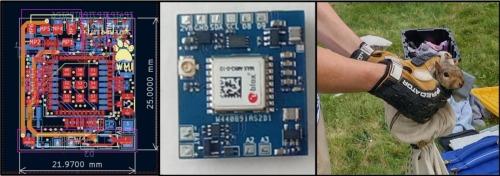Low-cost, LoRa GNSS tracker for wildlife monitoring
IF 2.1
Q3 ENGINEERING, ELECTRICAL & ELECTRONIC
引用次数: 0
Abstract
The advent of GNSS tracking has allowed researchers to obtain detailed information on animal movement, which informs basic natural history and conservation management decisions. However, many devices are tailored to specific taxa thus limiting broader applicability. We present an open-source LoRaWAN (long range wide area network) GNSS (Global Navigation Satellite System) tracker, and an alternative commercial-off-the-shelf (COTS) development board global positioning system (GPS) tracker, a subset of the GNSS system. The COTS development board tracker provides a pathway for designing and implementing a general purpose LoRaWAN tracking unit, while the advantages of the Wildlife Movement Institute (WMI) tracker permit specific animal tracking and additional information to be collected, such as battery voltage, estimated precision error, and received signal strength intensity. Both units have documentation for setting up a LoRa application and network server and can be easily programmed using the Arduino Integrated Development Environment. To test the utility of these trackers in a LoRa data transmission application, we pilot tested the units on Eastern gray squirrels in Syracuse, New York, USA. Our trackers highlight the capability for customizable, open-source tracking technology that can be tailored to a suite of study organisms allowing researchers to design, develop, and deploy low-cost, specialized wildlife tracking equipment.

用于野生动物监测的低成本LoRa GNSS追踪器
全球导航卫星系统追踪的出现使研究人员能够获得动物运动的详细信息,从而为基本的自然历史和保护管理决策提供信息。然而,许多设备是为特定的分类群量身定制的,因此限制了更广泛的适用性。我们提出了一个开源的LoRaWAN(远程广域网)全球导航卫星系统(GNSS)跟踪器,以及一个可替代的商用现货(COTS)开发板全球定位系统(GPS)跟踪器,这是GNSS系统的一个子集。COTS开发板跟踪器为设计和实现通用的LoRaWAN跟踪单元提供了一条途径,而野生动物运动研究所(WMI)跟踪器的优点是允许特定的动物跟踪和收集额外的信息,如电池电压、估计精度误差和接收信号强度。这两个单元都有关于设置LoRa应用程序和网络服务器的文档,可以使用Arduino集成开发环境轻松编程。为了测试这些跟踪器在LoRa数据传输应用中的实用性,我们在美国纽约州锡拉丘兹的东部灰松鼠身上进行了试点测试。我们的跟踪器突出了可定制的、开源的跟踪技术的能力,可以针对一套研究生物进行定制,使研究人员能够设计、开发和部署低成本的专业野生动物跟踪设备。
本文章由计算机程序翻译,如有差异,请以英文原文为准。
求助全文
约1分钟内获得全文
求助全文
来源期刊

HardwareX
Engineering-Industrial and Manufacturing Engineering
CiteScore
4.10
自引率
18.20%
发文量
124
审稿时长
24 weeks
期刊介绍:
HardwareX is an open access journal established to promote free and open source designing, building and customizing of scientific infrastructure (hardware). HardwareX aims to recognize researchers for the time and effort in developing scientific infrastructure while providing end-users with sufficient information to replicate and validate the advances presented. HardwareX is open to input from all scientific, technological and medical disciplines. Scientific infrastructure will be interpreted in the broadest sense. Including hardware modifications to existing infrastructure, sensors and tools that perform measurements and other functions outside of the traditional lab setting (such as wearables, air/water quality sensors, and low cost alternatives to existing tools), and the creation of wholly new tools for either standard or novel laboratory tasks. Authors are encouraged to submit hardware developments that address all aspects of science, not only the final measurement, for example, enhancements in sample preparation and handling, user safety, and quality control. The use of distributed digital manufacturing strategies (e.g. 3-D printing) is encouraged. All designs must be submitted under an open hardware license.
 求助内容:
求助内容: 应助结果提醒方式:
应助结果提醒方式:


